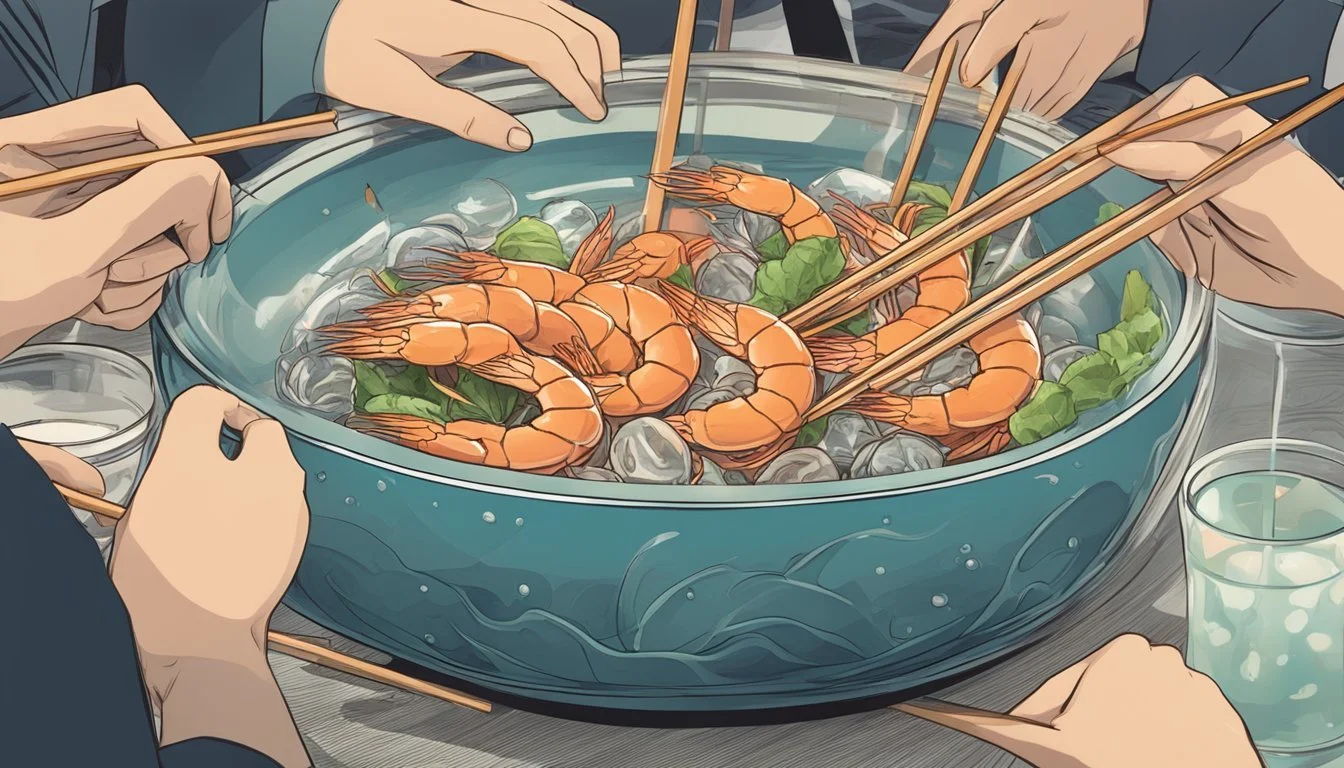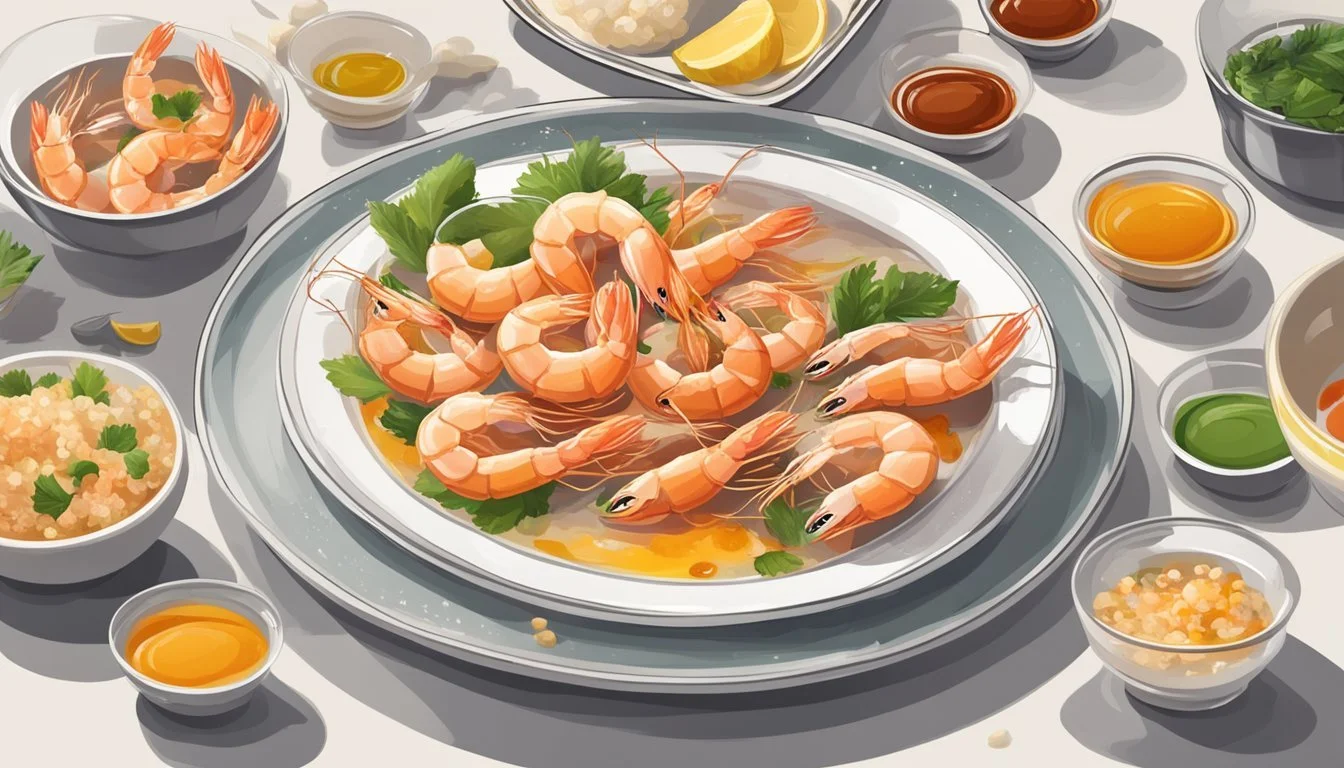Drunken Shrimp
Unpacking the Debate Around the Live Chinese Delicacy
In the realm of Chinese cuisine, the dish known as drunken shrimp (What wine goes well with shrimp?) stands out for its unique preparation and consumption methods, leading to various discussions about its ethical implications. The dish consists of live freshwater shrimp that are immersed in a strong liquor, typically a Chinese rice wine, which is believed to make the shrimp more palatable and add to the overall flavor of the dish. The alcohol serves a dual purpose: it infuses the shrimp with a distinct taste and intoxicates the creatures, making them less active and easier to eat.
Drunken shrimp is a delicacy that can be found in different regions across China, with each area potentially adding its own local twist to the recipe. While some preparations involve cooking the shrimp after they have been marinated in alcohol, other variations are served with the shrimp still alive, which is a practice that raises questions about animal welfare and dining ethics.
The dish's notoriety, in part, comes from the fact that it is often eaten raw, which is a matter of safety concern due to the potential risk of foodborne illnesses. Food enthusiasts and critics alike are divided on the consumption of drunken shrimp, with some celebrating its boldness and traditional roots, and others voicing their unease with the practice. Despite differing opinions, drunken shrimp continues to be a talked-about item, encapsulating a truly immersive cultural experience amidst contemporary culinary conversations.
Historical Context
Drunken Shrimp is a dish with a storied past, anchored deeply in Chinese culinary traditions. Its journey from a regional specialty to a global topic of discussion highlights the complex interplay of culture, ethics, and the evolution of cuisine.
Origin in Chinese Cuisine
Drunken Shrimp, known as 醉虾 (zuìxiā) in Mandarin, finds its roots in the rich gastronomic landscape of China. This dish is famous for featuring live shrimp that have been immersed in strong alcohol, typically a Chinese rice wine like "baijiu." The process makes the shrimp more pliable and enhances their flavor. Over the years, it has been prepared with various recipes across different regions of China, with some opting to serve the shrimp after it has been cooked, while others serve it while still live.
Global Perception and Variations
Outside China, Drunken Shrimp has sparked conversation and controversy due to the practice of consuming live animals. Dishes like Yin and Yang fish have faced similar scrutiny. Global reactions range from intrigue to ethical concern, with organizations such as People for the Ethical Treatment of Animals condemning such practices. Variations of the dish cater to a more international palate, adapting the method to involve cooking the shrimp, thus removing the element of live consumption. Despite differing views, Drunken Shrimp remains a culinary phenomenon that invites debate and reflects the diverse attitudes towards food practices around the world.
Preparation and Ingredients
The preparation of Drunken Shrimp involves selecting live shrimp, marinating them in alcohol, and occasionally pairing them with flavorful accompaniments. This dish is known for its freshness and is served alive, which adds to its controversial status.
Selecting the Shrimp
The foundation of Drunken Shrimp is fresh prawns or shrimp, chosen for their liveliness and quality. Typically, the smaller, freshwater varieties are preferred for their sweeter flavor. They should be vigorous and active, ensuring the freshest experience upon serving.
The Marinating Process
Marinating is a crucial step in the preparation of Drunken Shrimp, where the selected shrimp are submerged in a strong liquor, commonly a Chinese rice wine, which may be seasoned with salt and sugar to taste. The process is brief, lasting just long enough for the shrimp to consume the alcohol and become 'drunken'. It's important to note that some diners prefer to devein the shrimp during this step for a cleaner taste.
Accompaniments and Garnishes
Drunken Shrimp is often paired with additional flavors to enhance the dish:
Sauce: A sweet and sour sauce or a simple soy sauce mixture can be offered for dipping.
Garnishes: Fresh garnishes such as parsley, slices of lemon, or minced garlic (What wine goes well with garlic?) can be used to augment the flavor.
These items allow diners to tailor the dish to their taste preferences and can be used sparingly or liberally.
Drunken Shrimp Varieties
Drunken shrimp, a traditional Chinese delicacy, comes in various preparations, ranging from the classic raw method to modern cooked versions. These dishes are renowned for their unique presentation and the burst of flavors that combine the natural sweetness of shrimp with the depth of alcoholic beverages like Shaoxing wine.
Traditional Drunken Shrimp
Traditional drunken shrimp, a favorite in Chinese cuisine, involves live freshwater prawns that are marinated briefly in a strong liquor, typically Shaoxing wine. This process imparts a subtle sweetness and complements the natural flavor of the prawns.
Ingredients: Live freshwater shrimp, Shaoxing wine
Preparation: Shrimp are submerged alive, briefly, in Shaoxing wine which enhances flavor and eases consumption.
Modern Interpretations
Modern versions of drunken shrimp have emerged, often incorporating additional ingredients such as garlic, ginger, and honey that enhance the dish's complexity.
Cooking Technique: Sautéing with garlic and ginger; sometimes flambéed with whiskey
Flavour Profile: Richer taste with added sweetness and aromatic spices
Alcohol Variants: Use of different spirits like whiskey while keeping rice wine as a base
Cultural Significance
The dish known as Drunken Shrimp holds a unique position in Chinese cuisine, reflecting aspects of tradition and celebration. Its preparation and consumption are steeped in cultural significance and are linked to regional festivities, making it more than just a culinary choice.
Symbolism in Chinese Culture
In Chinese culture, specific foods often carry symbolic meanings, and Drunken Shrimp is no exception. Shrimp in Chinese is xiā, which is a homophone for laughter or the sound of laughing (haha). Due to this linguistic association, consuming shrimp is sometimes akin to inviting joy and happiness into one's life. Moreover, the particular preparation of the shrimp, alive and infused with spirits, can symbolize vitality and the energy of life in a direct and palpable manner. This vivid display of liveliness and the ritual of eating such an animated dish align with Chinese cultural values that treasure life and vigor.
Associations with Festivities
Drunken Shrimp often finds its place in various regional festivities across China. For example, during certain local festivals, such as those in Chiayi, a city known for its aquatic gastronomy, the dish becomes a focal point for celebrations. These festivals may praise the abundance of local produce or mark historical events significant to the community. Serving a dish like Drunken Shrimp conveys respect for tradition and a communal sense of belonging. Festivities in China are multifaceted events with food playing a central role in the proceedings, and Drunken Shrimp contributes to such occasions with its distinctive preparation and the convivial atmosphere it helps foster.
Ethical and Health Considerations
The ethical debate and health concerns surrounding the consumption of 'Drunken Shrimp' are significant. They revolve primarily around the custom of serving the shrimp alive and the implications for both human health and animal welfare.
Controversy Surrounding Live Serving
The practice of serving 'Drunken Shrimp' alive, known as yi yang yu, has sparked considerable ethical debate. Animal welfare advocates argue that the practice is inhumane, as the live shrimp are immersed in strong liquor, which can be seen as a distressing method of preparation. This has led to a call for the dish to be banned in some regions. Live serving has garnered not just domestic criticism but also international concern, with many finding the practice disturbing.
Ethical concerns:
Animal welfare: The distress caused to shrimp served alive.
Cultural sensitivity: The dish is a traditional practice in some regions, leading to cultural debates.
Health Risks and Food Safety
Health risks associated with consuming 'Drunken Shrimp'—whether served dead or alive—can be serious. There's a risk of parasitic infections such as lung flukes, which can be prevalent in freshwater shrimp. Eating them raw or undercooked, which is often the case when they are served alive, could lead to such infections. Food safety regulations in various jurisdictions may prohibit the sale of live aquatic animals for consumption to mitigate these risks.
Health risks of consuming raw shrimp:
Parasitic infections: Potential transmission of parasites like lung flukes.
Food safety: Ensuring shrimp are free from pathogens is challenging when served alive.
By acknowledging both the ethical considerations and the health risks, one can fully grasp the complexity surrounding the consumption of 'Drunken Shrimp'.
Culinary Techniques
In the preparation of Drunken Shrimp, chefs apply specific marination and seasoning strategies before serving. These techniques aim to enhance the flavors while ensuring the dish's signature live presentation remains intact.
Marination and Seasoning
The marination process involves immersing live freshwater shrimp in a potent alcohol, commonly a strong Chinese rice wine. Key ingredients in the marinade include:
Ginger: Thinly sliced for a piquant aroma.
Soy sauce: Adds a savory note.
Alcohol: Typically, rice wine or baijiu; it relaxes the shrimp.
Table 1: Marination Ingredients and Proportions
Ginger: Amount - 2-3 slices, Function - Aroma
Soy sauce: Amount - As needed, Function - Salty and umami flavor
Rice wine: Amount - Enough to cover, Function - Marinates and intoxicates shrimp
The preparation involves a brief submersion, keeping the shrimp alive but sedated. A critical tool for this process is the wok, which is often used to quickly toss the shrimp with seasonings, ensuring even coating without cooking them.
Presentation and Serving Methods
Presentation is crucial for Drunken Shrimp, and it typically involves a lively display. Shrimp are served immediately after marination to preserve their intended liveliness. Accompanying garnishes include:
Lemon: Adds freshness and a citrus zest when squeezed over the shrimp.
Onion: Offers a sharp, yet sweet crunch.
Red pepper: Provides a burst of color and mild heat.
Arrangement on the serving plate is performed with care to maximize aesthetic appeal, with garnishes strategically placed for both visual and gustatory enhancement. It is traditional for diners to consume the shrimp quickly after being served, preserving the unique texture and flavor profile of the live seafood.
Pairings and Complimentary Dishes
Drunken shrimp, while a standalone dish, pairs well with various side dishes and beverages that enhance its unique flavor. The section below outlines ideal companions for this dish, each selected to complement its strong, spirited taste.
Recommended Side Dishes
Steamed Rice: A bowl of plain, steamed rice serves as a neutral base, balancing the intense flavor of the drunken shrimp.
Blanched Vegetables: Lightly cooked vegetables such as bok choy or spinach offer a refreshing contrast to the dish's rich taste.
Oysters (What wine goes well with oysters?): As another seafood delicacy, oysters can accompany drunken shrimp, especially when served with a light, tangy dressing.
Lobster (What wine goes well with lobster?): For an indulgent seafood feast, lobster, whether steamed or grilled, can share the stage with drunken shrimp, offering a sweet and succulent texture.
Wine and Beverage Pairings
White Wine: A crisp, dry white wine balances the shrimp's boozy marinade, without overpowering its delicate flavors.
Sauvignon Blanc: Its bright acidity cuts through the richness of the dish.
Chardonnay: A lighter Chardonnay complements the shrimp with its subtle fruity notes.
Chinese Rice Wine: Should guests opt for full authenticity, sipping on the same rice wine used in preparing the shrimp can be a fitting choice.
Tea: A pot of jasmine or green tea can cleanse the palate between bites, offering a floral aroma that contrasts the savory, alcohol-infused shrimp.
Global Influence and Adaptation
Drunken shrimp, a Chinese dish traditionally served live, has impacted culinary practices around the globe and undergone various adaptations. This section explores how this exotic dish compares to similar culinary traditions and its influence on international cuisine.
Comparison with Similar Dishes
Drunken shrimp holds a unique position in global culinary traditions due to its live serving style. It shares some commonalities with sashimi, a Japanese delicacy that frequently features raw seafood, such as fish and shrimp. Korean cuisine offers a parallel with live dishes like sannakji, where live octopus is served, often seasoned with sesame seeds and oil. While consuming seafood live is a noted feature in East Asian dining, in Western countries, particularly Italy, raw seafood is commonly prepared as 'crudo' but not served alive.
Influence on International Cuisine
The idea of drunken shrimp has intrigued chefs and food enthusiasts worldwide, leading to adaptations that cater to local palates and food safety standards. In regions outside of China, the dish might be modified to include a brief cooking or curing process, eliminating the live aspect but retaining the dish's bold flavors. Drunken shrimp's principle of marinating seafood in alcohol has inspired similar preparations across various cuisines, albeit with regional twists, such as using local liquors or adding native herbs and spices. This cross-cultural culinary exchange has expanded the dish's presence, making it a quirky yet noteworthy point of reference for experimental seafood preparations.





